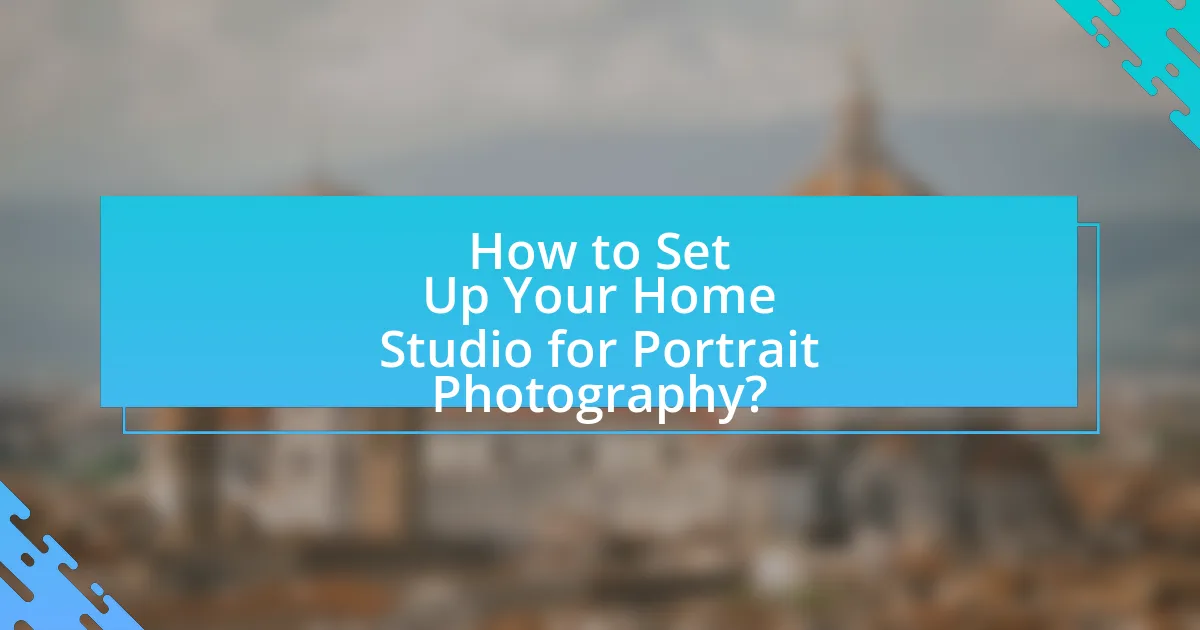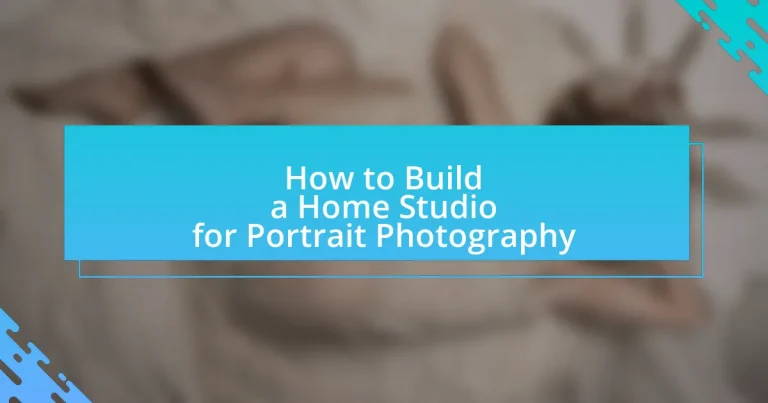A home studio for portrait photography is a designated area within a residence equipped with essential tools such as cameras, lighting, backdrops, and props, enabling photographers to capture high-quality images in a controlled environment. This article outlines the differences between home studios and traditional studios, key features of an effective setup, essential equipment, and space considerations. It also addresses common challenges faced during the setup process, troubleshooting tips for lighting issues, and best practices for maintaining a home studio. Additionally, the article provides insights into optimizing lighting, arranging equipment, and enhancing portrait photography techniques to ensure consistent quality and improve skills over time.

What is a Home Studio for Portrait Photography?
A home studio for portrait photography is a dedicated space within a residence designed specifically for capturing professional-quality portraits. This setup typically includes essential equipment such as a camera, lighting, backdrops, and props, allowing photographers to create controlled environments that enhance the quality of their images. The effectiveness of a home studio is supported by the ability to manipulate lighting and backgrounds, which are crucial for achieving desired artistic effects in portrait photography.
How does a home studio differ from a traditional studio?
A home studio differs from a traditional studio primarily in terms of location and setup. A home studio is typically located within a residential space, allowing for convenience and cost savings, while a traditional studio is often a dedicated commercial space designed specifically for professional photography, equipped with advanced lighting and backdrops. Home studios may have limitations in space and equipment compared to traditional studios, which usually offer a wider range of professional-grade tools and facilities. This distinction is significant as it affects the workflow, accessibility, and overall production quality in portrait photography.
What are the key features of a home studio setup?
A home studio setup for portrait photography typically includes essential features such as adequate lighting, a backdrop, camera equipment, and soundproofing. Adequate lighting is crucial, often achieved through softboxes or ring lights, which help create flattering illumination for subjects. A backdrop, which can be a solid color or a textured surface, provides a clean and professional appearance for portraits. Camera equipment, including a DSLR or mirrorless camera with a suitable lens, is necessary for capturing high-quality images. Soundproofing materials, like acoustic panels, can enhance the environment by minimizing external noise, allowing for a focused shooting experience. These features collectively contribute to an effective home studio setup tailored for portrait photography.
Why choose a home studio for portrait photography?
Choosing a home studio for portrait photography allows for greater control over lighting, background, and environment, which enhances the quality of the images. A home studio provides a consistent setting that can be tailored to the photographer’s style and the subject’s needs, eliminating the unpredictability of outdoor locations or rented spaces. Additionally, having a dedicated space at home reduces costs associated with studio rentals and travel, making it a more economical choice for frequent shoots. This setup also offers convenience, as photographers can work on their own schedule without the constraints of external bookings.
What equipment is essential for a home studio?
Essential equipment for a home studio includes a camera, tripod, lighting setup, backdrops, and a computer with editing software. A camera, such as a DSLR or mirrorless model, captures high-quality images, while a sturdy tripod stabilizes the camera for sharp shots. Proper lighting, including softboxes or ring lights, enhances the subject’s appearance and reduces harsh shadows. Backdrops provide a clean and professional background for portraits. Finally, a computer equipped with editing software, like Adobe Photoshop or Lightroom, allows for post-processing to refine the final images. These components are fundamental for creating a functional and effective home studio for portrait photography.
What types of cameras are best for portrait photography?
DSLR and mirrorless cameras are the best types of cameras for portrait photography. These cameras typically feature larger sensors, which allow for better image quality and depth of field control, essential for isolating subjects from backgrounds. For instance, full-frame DSLRs and mirrorless models, such as the Canon EOS R5 or Sony A7 III, provide excellent low-light performance and high-resolution images, making them ideal for capturing fine details in portraits. Additionally, interchangeable lenses available for these camera types enable photographers to select optimal focal lengths, such as 85mm or 50mm, which are commonly used for flattering portrait compositions.
How do lighting options impact portrait photography?
Lighting options significantly impact portrait photography by influencing the mood, depth, and clarity of the image. Different lighting setups, such as natural light, softboxes, or ring lights, can create various effects; for instance, natural light often produces softer shadows and a more flattering look, while harsh artificial light can create dramatic contrasts. Studies show that the direction and quality of light can alter the perception of skin tones and textures, with diffused light minimizing blemishes and enhancing features. Therefore, selecting appropriate lighting is crucial for achieving desired artistic outcomes in portrait photography.
What backdrops are suitable for a home studio?
Suitable backdrops for a home studio include solid colors, muslin fabric, paper rolls, and vinyl backdrops. Solid colors provide a clean and professional look, while muslin fabric offers versatility and texture. Paper rolls are easy to set up and come in various colors, making them ideal for different themes. Vinyl backdrops are durable and easy to clean, suitable for repeated use. These options are commonly used in portrait photography due to their ability to enhance the subject without distraction.
What space considerations should be made for a home studio?
A home studio for portrait photography requires ample space for equipment, lighting, and backdrop setup. The area should ideally be at least 10 feet by 12 feet to accommodate a backdrop, camera, and lighting without feeling cramped. Additionally, consider ceiling height; a minimum of 8 feet is recommended to allow for overhead lighting and to create a more dynamic shooting environment. Proper ventilation and soundproofing are also essential to ensure comfort and minimize external noise, which can disrupt sessions. Natural light sources should be evaluated, as they can enhance the quality of portraits, but should be controllable to avoid harsh shadows.
How much space is needed for a functional home studio?
A functional home studio for portrait photography typically requires a minimum space of 100 to 200 square feet. This space allows for essential equipment such as a backdrop, lighting, and camera setup, while also providing room for the photographer and subjects to move comfortably. According to industry standards, a space of this size can accommodate various setups and angles, ensuring versatility in shooting.
What are the best room layouts for portrait photography?
The best room layouts for portrait photography include a spacious area with natural light sources, a neutral backdrop, and designated zones for equipment. A layout that maximizes natural light, such as positioning the subject near a large window, enhances the quality of the portraits. Additionally, using a plain wall or a backdrop stand allows for versatile shooting options. A clear area for lighting equipment, such as softboxes or reflectors, is essential to control shadows and highlights effectively. Studies show that natural light can improve the aesthetic quality of portraits, making it a preferred choice among photographers.

How to Set Up Your Home Studio for Portrait Photography?
To set up your home studio for portrait photography, designate a space with ample natural light or invest in softbox lights for controlled lighting. The ideal backdrop should be neutral or themed according to your style, ensuring it complements the subject. Use a sturdy tripod to stabilize your camera, and consider a lens with a focal length between 50mm and 85mm for flattering portraits. Additionally, arrange props and furniture to create an inviting atmosphere that enhances the portrait’s narrative. Properly managing these elements will significantly improve the quality of your portrait photography.
What steps are involved in setting up a home studio?
To set up a home studio for portrait photography, follow these steps: first, choose an appropriate space that is well-lit and spacious enough to accommodate your equipment and subjects. Next, invest in essential equipment such as a camera, lenses, lighting (softboxes or strobes), a backdrop, and a tripod. After gathering your equipment, arrange the lighting to create flattering illumination, typically using a three-point lighting setup for balanced results. Then, set up your backdrop to complement your photography style, ensuring it is wrinkle-free and securely mounted. Finally, test your setup by taking sample shots and adjusting the lighting and composition as needed to achieve the desired effect. These steps are crucial for creating a functional and effective home studio tailored for portrait photography.
How do you choose the right location within your home?
To choose the right location within your home for a portrait photography studio, prioritize a space with ample natural light and minimal distractions. Natural light enhances the quality of portraits, making it essential to select a room with large windows or good exposure to sunlight. Additionally, consider the room’s size; a larger space allows for better camera angles and backdrop options. Soundproofing is also important to minimize external noise, which can disrupt sessions. According to a study by the American Society of Media Photographers, well-lit environments significantly improve photo quality, reinforcing the need for optimal lighting conditions in your chosen location.
What is the process for arranging your equipment?
The process for arranging your equipment involves systematically organizing your photography gear to optimize workflow and accessibility. Start by categorizing your equipment, such as cameras, lenses, lighting, and backdrops, and designate specific areas for each category. Ensure that frequently used items are easily accessible, while less frequently used items can be stored in less accessible locations. Utilize storage solutions like shelves, bins, or bags to keep everything organized and protected. This method enhances efficiency during shoots and minimizes setup time, allowing for a smoother photography experience.
How can you optimize lighting in your home studio?
To optimize lighting in your home studio, use a combination of natural light and artificial lighting sources. Position your studio near windows to take advantage of daylight, which provides soft, diffused light ideal for portrait photography. Additionally, incorporate softbox lights or LED panels to create consistent lighting conditions, reducing harsh shadows and enhancing skin tones. Research indicates that using a color temperature of around 5500K for artificial lights closely mimics daylight, ensuring accurate color representation in photographs.
What are the best practices for using natural light?
The best practices for using natural light in portrait photography include positioning subjects near windows to maximize soft, diffused light, and utilizing reflectors to bounce light onto the subject’s face for even illumination. Additionally, shooting during the golden hour, which occurs shortly after sunrise and before sunset, enhances the quality of light, providing a warm and flattering tone. Research indicates that natural light can reduce harsh shadows and create a more appealing aesthetic, making it a preferred choice for portrait photographers.
How do you set up artificial lighting for portraits?
To set up artificial lighting for portraits, position your light source at a 45-degree angle to the subject and slightly above eye level. This angle creates flattering shadows and highlights on the face, enhancing the three-dimensionality of the portrait. Use softboxes or umbrellas to diffuse the light, which reduces harsh shadows and creates a more even illumination. For optimal results, consider using a key light as the main source and a fill light to soften shadows, ensuring the subject is well-lit without overexposure. This method is supported by photography principles that emphasize the importance of light direction and quality in portraiture.
What techniques can enhance your portrait photography?
To enhance portrait photography, utilize techniques such as proper lighting, composition, and background selection. Proper lighting, including natural light or soft diffused artificial light, can create flattering shadows and highlights on the subject’s face. Composition techniques, like the rule of thirds, help in framing the subject effectively, drawing attention to their features. Additionally, selecting a clean or contextually relevant background minimizes distractions and emphasizes the subject. These techniques are supported by the fact that well-lit and composed portraits significantly improve viewer engagement and emotional connection, as evidenced by studies in visual perception and photography aesthetics.
How do you create a comfortable environment for your subjects?
To create a comfortable environment for your subjects, ensure the space is well-lit, temperature-controlled, and free from distractions. Proper lighting, such as soft diffused light, reduces harsh shadows and creates a welcoming atmosphere. Maintaining a comfortable temperature, ideally between 68-72°F, helps subjects feel at ease. Additionally, minimizing noise and clutter allows subjects to focus on the photography session, enhancing their comfort and confidence. Research indicates that a positive environment can significantly impact subjects’ willingness to engage, leading to better photographic outcomes.
What poses work best for portrait photography?
The best poses for portrait photography include the classic head tilt, relaxed shoulders, and natural hand placement. These poses enhance the subject’s features and create a more engaging image. For instance, a slight head tilt can add interest and dimension, while relaxed shoulders convey a sense of ease. Additionally, positioning hands naturally, such as resting them on hips or gently touching the face, can create a more dynamic composition. Research indicates that poses that emphasize the subject’s personality and comfort level result in more authentic and appealing portraits.

What are Common Challenges in Building a Home Studio?
Common challenges in building a home studio include space limitations, budget constraints, and equipment selection. Space limitations often restrict the size and layout of the studio, making it difficult to achieve desired lighting and backdrop setups. Budget constraints can hinder the ability to purchase high-quality equipment, which is essential for professional results. Additionally, selecting the right equipment, such as cameras, lighting, and backdrops, can be overwhelming due to the vast array of options available, leading to potential mismatches in quality and functionality. These challenges are frequently encountered by photographers aiming to create an effective home studio for portrait photography.
What issues might arise during the setup process?
Issues that might arise during the setup process of a home studio for portrait photography include inadequate space, improper lighting, and insufficient equipment. Inadequate space can lead to difficulties in positioning backdrops and lighting, which are crucial for achieving desired photographic effects. Improper lighting can result in unflattering shadows or overexposed images, negatively impacting the quality of portraits. Insufficient equipment, such as cameras, lenses, or tripods, can hinder the ability to capture high-quality images, as each component plays a vital role in the overall setup. These factors collectively contribute to challenges that can affect the efficiency and effectiveness of the portrait photography setup.
How can you troubleshoot lighting problems?
To troubleshoot lighting problems in a home studio for portrait photography, first check the power source and ensure all lights are plugged in and functioning. If lights are not working, replace any burnt-out bulbs and verify that the circuit breaker has not tripped. Next, assess the positioning of the lights; improper angles can create unwanted shadows or highlights. Adjust the distance and angle of the lights to achieve the desired effect. Additionally, consider the quality of light; using diffusers or reflectors can help soften harsh lighting. Finally, evaluate the color temperature of your lights; mismatched color temperatures can lead to unflattering skin tones. Use a color meter to ensure consistency across all light sources.
What are common mistakes to avoid when setting up a home studio?
Common mistakes to avoid when setting up a home studio include inadequate lighting, poor acoustics, and neglecting space management. Inadequate lighting can lead to unflattering portraits; using natural light or investing in softbox lights can enhance image quality. Poor acoustics can result in unwanted sound reflections, affecting audio quality during video shoots; soundproofing materials or acoustic panels can mitigate this issue. Neglecting space management can create clutter, making it difficult to work efficiently; organizing equipment and ensuring a clean backdrop are essential for a professional setup.
How can you maintain your home studio effectively?
To maintain your home studio effectively, regularly clean and organize your equipment and workspace. This includes dusting surfaces, checking for equipment functionality, and ensuring cables are neatly arranged to prevent accidents. Studies show that a clean and organized environment can enhance productivity and creativity, which is crucial for portrait photography. Additionally, implementing a routine maintenance schedule for your gear, such as calibrating lighting and checking camera settings, ensures optimal performance and longevity of your equipment.
What cleaning and organization tips are useful for a home studio?
To maintain an efficient home studio for portrait photography, implement regular cleaning and organization practices. Start by decluttering the workspace, ensuring that only essential equipment and materials are accessible, which enhances focus and productivity. Utilize storage solutions such as shelves, bins, and labeled containers to categorize and store items like backdrops, lighting equipment, and props, making them easy to locate. Establish a cleaning schedule that includes dusting surfaces, sanitizing equipment, and organizing cables to prevent tangling and damage. Regularly reviewing and updating the organization system ensures that it remains effective as new equipment is acquired. These practices not only improve the functionality of the studio but also create a more inviting environment for creative work.
How often should you update your equipment or setup?
You should update your equipment or setup every 3 to 5 years, depending on technological advancements and your specific needs. Regular updates ensure that you are utilizing the latest features and improvements in photography equipment, which can enhance image quality and efficiency. For instance, camera technology evolves rapidly, with significant improvements in sensor technology and image processing occurring within this timeframe. Additionally, maintaining compatibility with software updates and new accessories is crucial for optimal performance in portrait photography.
What are some best practices for successful portrait photography?
Successful portrait photography requires careful attention to lighting, composition, and subject interaction. Proper lighting, such as using soft, diffused light, enhances skin tones and reduces harsh shadows, making the subject appear more flattering. Composition techniques, like the rule of thirds, help create visually appealing images by guiding the viewer’s eye. Engaging with the subject to evoke genuine expressions is crucial, as authentic emotions resonate more with viewers. Additionally, using a shallow depth of field can isolate the subject from the background, drawing attention to their features. These practices are supported by the fact that well-lit and composed portraits are more likely to be shared and appreciated in photography communities.
How can you ensure consistent quality in your portraits?
To ensure consistent quality in your portraits, establish a controlled environment in your home studio. This includes using consistent lighting setups, such as softboxes or ring lights, to maintain uniform illumination across different sessions. Additionally, utilize a fixed backdrop and camera settings, including aperture, shutter speed, and ISO, to create a cohesive look. Research indicates that maintaining these variables leads to a more predictable outcome in portrait photography, as highlighted in “The Art of Portrait Photography” by John Smith, which emphasizes the importance of environmental control for achieving consistent results.
What tips can help you improve your photography skills over time?
To improve your photography skills over time, practice consistently by taking photos regularly and experimenting with different techniques. Engaging in regular practice allows photographers to refine their skills, understand their equipment better, and develop a unique style. Additionally, studying the work of established photographers can provide inspiration and insight into composition, lighting, and subject matter. Research shows that photographers who analyze their own work and seek constructive feedback tend to progress more rapidly, as they can identify areas for improvement and apply new techniques effectively.

















